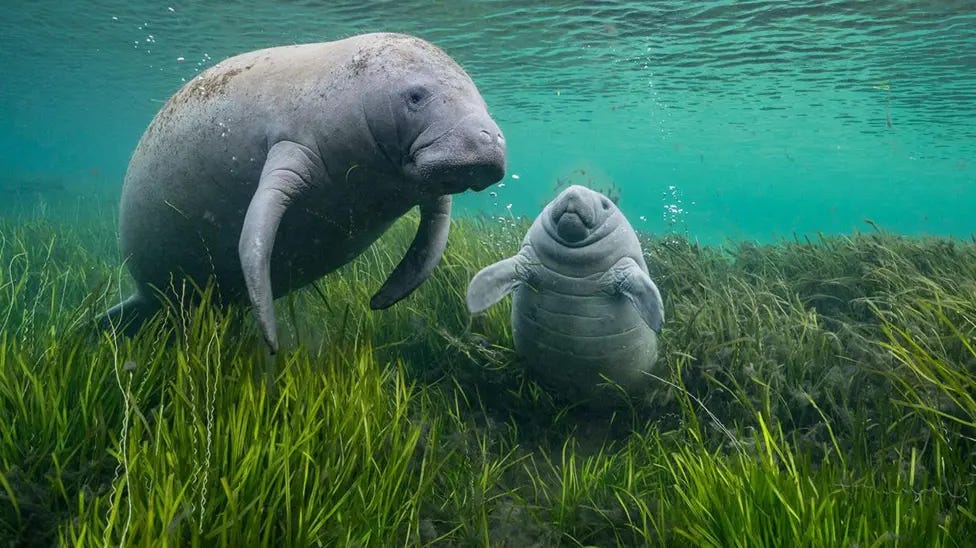Welcome to the latest edition of the Big Blue Bulletin – things have changed just a little bit around here as featured stories will now focus on whales, dolphins, and porpoises, with a little bit of commentary from me thrown in as well. Still, you can expect good news, bad news, and a cute creature in your inbox every Friday.
Let’s dive in 🐬
Ocean news
🗞️ Big news of the week -
🚽 The stunning power of whale pee
Scientists have long recognised the role of whale poo—known as the whale pump—in fertilising the ocean. However, recent research has just revealed that urine is just as essential.
A new study published in Nature Communications shows that whale urine plays a crucial role in sustaining marine ecosystems. Baleen whales—including blue, humpback, and fin whales—release thousands of tons of nitrogen and organic matter into nutrient-poor areas through their urine, carcasses, and placentas. Urine alone is the largest source of nitrogen, with a single fin whale producing over 250 gallons of it every day.
One day, we’ll learn that the very existence of whales is a benefit—to us, to the planet, and to the ocean. Until then, celebrating the scientific benefits of their pee will have to do.
❄️ A changing Arctic current seems to be impacting bowhead whales
Teen researcher Addison Shea, set out to understand how changing ocean currents might be affecting Arctic wildlife. Her focus was on the Beaufort Gyre, a current off the coast of northern Canada and Alaska that used to switch direction every five to seven years—but hasn’t done so in over two decades.
By mapping bowhead whale sightings, Addison found that their average locations suggest they may be starting their migrations earlier in the fall or spending summers farther west.
As the Arctic continues to change, so do the creatures that call it home as bowhead whales have survived a shifting climate for millions of years. It’s hard to fathom exactly how wildlife are capable of reacting to these changes at all, but how much more they’ll be forced to adapt to, remains to be seen.
🇧🇷 Dolphins and humans team up to catch fish in Brazil
For generations, dolphins and fishermen in Laguna, Brazil, have been working together to catch fish—a rare example of interspecies cooperation that benefits both sides.
A new study, published in Current Zoology, used drone footage to reveal just how coordinated this partnership is. The footage revealed that the Lahille’s bottlenose dolphins herd schools of mullet toward the shallows, where local fishermen wait for the signal—a tail slap or sudden dive—before casting their nets. The dolphins capitalise on the chaos by either grabbing fish trapped against the outside of the nets or picking off any stragglers.
In a world where human impact so often threatens marine life, it's refreshing to see both species benefit rather than compete.
🔊 Scientists listen to 'dolphin whistling' to track numbers off Northumberland coast
Scientists from Newcastle University are tuning into the whistles of bottlenose dolphins to estimate their numbers off the Northumberland coast. Using hydrophones anchored at Druridge Bay, Newbiggin-by-the-Sea, and St Mary’s Island, researchers have been recording signature whistles—unique calls used by individual dolphins to communicate.
Their findings suggest that 60 to 70 dolphins regularly visit the area, making up about a third of the East Coast population that ranges from the Moray Firth to Scarborough. Traditionally, dolphin numbers have been monitored through boat-based photographic surveys, but this acoustic method offers a more efficient and non-intrusive alternative.
The North Sea these species live and forage in is the same North Sea where a recent collision occurred between a cargo ship and an oil tanker. The oil tanker was carrying 220,000 barrels of jet fuel, some of which have 'ruptured' meaning the toxic substance is currently pouring out into the sea and threatening all marine life in the area. This is a reminder that while we continue to learn about these incredible species, we also continue to put them at risk.
🦄 Scientists discover narwhals putting their long tusks to surprising new use
New drone footage has captured narwhals using their iconic tusks to manipulate fish—and even engage in what appears to be playful behaviour.
The study, published in Frontiers in Marine Science, provides the first evidence of narwhals using their tusks to probe, influence, and interact with their prey. While their tusks have long been a mystery, this footage suggests they may serve more than just a competitive or sensory role.
In a rapidly changing Arctic, understanding these behaviours could offer new insights into social learning, personality differences, and exactly how these elusive whales adapt to their cold environment.
Have a great weekend! 📸
Cover image by wildestanimal/Moment/Getty Images Plus.






Many thanks for posting. The whale urine info is just another reminder of home many different elements are lost to the ecosystem when whales disappear from it.
Awesome list this round, Amie.🐋